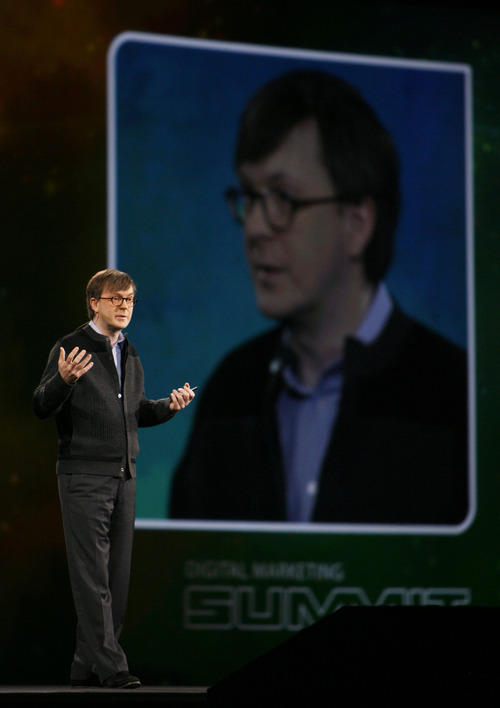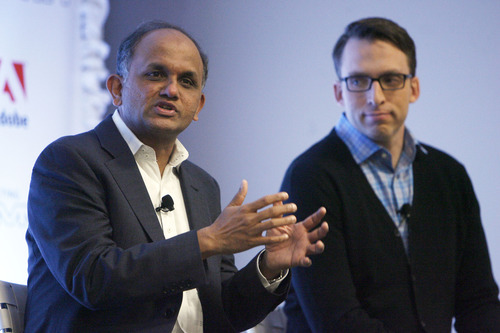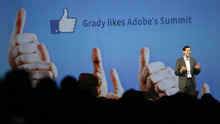This is an archived article that was published on sltrib.com in 2012, and information in the article may be outdated. It is provided only for personal research purposes and may not be reprinted.
As Adobe Systems Inc. makes a major push into online marketing tools, its Utah operations take on a more important role, company officials said Wednesday.
Adobe officials announced a slate of new products and upgrades Wednesday at their annual Salt Lake City conference as they make digital marketing a bigger part of the business known mostly for its design and publishing software.
Adobe is made up of two divisions, with the digital marketing business anchored in Utah.
CEO Shantanu Narayen said the company's 2009 purchase of Orem-based Omniture Inc. has been a "cornerstone" for the company's push into digital marketing.
"In a word, we're thrilled about how the acquisition has gone," Narayen told reporters and analysts. "It's really put us in a leadership position in this entire digital marketing category."
Before the acquisition, Omniture was the leader in providing software and services that analyzed traffic to websites and helped businesses improve online sales.
After the Omniture deal, San Jose, Calif.-based Adobe purchased five other business and used the six to form its digital marketing unit.
It is constructing a facility in Lehi in northern Utah County just off Interstate 15 and below the Cabela's sporting goods store.
"We're looking at this site … as focusing not just on the digital but on other stuff that's happening," said Narayen.
Brad Rencher, senior vice president and general manager of the company's digital marketing business, said employees would be moving into the building in October or November.
Rencher, a former Omniture officer, said the building was the first phase of a plan for a Utah campus.
The first building will have room for about 1,100 people and, "I expect we'll be pretty darn close to filling it up."
Future construction at the site will depend on Adobe's growth, he said.
About 4,000 people attended the conference at the Calvin L. Rampton Salt Palace Convention Center in downtown Salt Lake City for speeches and workshops, mostly on Wednesday and Thursday.
"We've developed into one of the world's largest digital marketing conferences," said Matt Langie, director of product marketing.
The conference was centered around Adobe's new products and updates of old ones, but it really was like an old-time tent revival, not for religion but for digital media and marketing as the next wave beyond traditional television and print publications.
"People get very nervous about moving away from a historical model of using television or print to get to their audiences," said Ann Lewness, senior vice president of global marketing. "We think that's hogwash. We're not against TV. I'm all for TV. We're not against print, but you can get the same type of results and much more measurable results from digital."
Though a pioneering online publisher, keynote speaker Arianna Huffington, founder and editor of the Huffington Post website, sounded notes of caution about the rapidly emerging digital world. She warned of a "snake in the garden" where "digital life" and "real life" are merging and people are "hyperconnected" and many sleep deprived.
"I speak as somebody who lives my life in a hyperconnected world with three BlackBerrys and two iPhones and an iPad in a digital newsroom," Huffington said. "So I'm here to tell this is a paradox that we need to address. If we don't learn to disconnect, to unplug and recharge, we are cooked."
The new products from Adobe are aimed at more specific marketing to consumers through email and other digital media such as Web pages, as well as devices such as mobile phones.
So, for example, if a 25-year-old woman landed on a Web page of an outdoor sports equipment company, she would see products aimed at her gender, age and preferences. A 55-year-old man would see a different set of products geared toward his gender, age and sports preferences.
The information on the customers could be gleaned by data on what they looked at on the website, whether they filled out registration information or from their interactions on social media sites such as Facebook and Twitter.
But Narayen and others made a point of saying that customer privacy preferences would drive what information is collected and used. "We have to make consumers be in control of what they are willing to share and what we're not willing to share," Narayen said.
Still, he and others said many consumers will agree to share information about themselves in return for more personalized experiences in accessing websites or information on their mobile phones.
tharvey@sltrib.com Twitter: @TomHarveySltrib. #adobesummit













